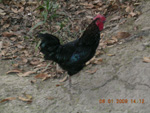Conserving indigenous poultry breeds - Black Haringhata and Aseel in West Bengal
May 15, 2009
In a joint effort by the Govt of West Bengal and West Bengal University of Animal and Fishery Sciences, a programme for in-situ conservation of Haringhata Black and Aseel breeds of indigenous poultry has been initiated for the first time in West Bengal with the financial support being provided by the Ministry of Agriculture, Govt of India.
 In India, rural backyard poultry is reared by poorest of the poor especially women. Despite being an unorganized sector, the socio-cultural, economical and nutritional security provided by the backyard or small holder poultry cannot be undermined. The indigenous birds require minimal inputs in form of night shelter, a fistful of grains, kitchen leftovers, a scavenging area and are well adapted to local conditions. Over a period of time due to various reasons (availability of commercial broilers and layers at cheaper rates, outbreaks of Avian Influenza, New Castle disease etc), the population of indigenous birds has decreased at an alarming rate. In view of this various efforts are being initiated to conserve the indigenous poultry.
In India, rural backyard poultry is reared by poorest of the poor especially women. Despite being an unorganized sector, the socio-cultural, economical and nutritional security provided by the backyard or small holder poultry cannot be undermined. The indigenous birds require minimal inputs in form of night shelter, a fistful of grains, kitchen leftovers, a scavenging area and are well adapted to local conditions. Over a period of time due to various reasons (availability of commercial broilers and layers at cheaper rates, outbreaks of Avian Influenza, New Castle disease etc), the population of indigenous birds has decreased at an alarming rate. In view of this various efforts are being initiated to conserve the indigenous poultry.
Haringhata Black (or Black Haringhata), an indigenous fowl genetic resource came to the notice of scientists, planners and developers 25 years back by virtue of its superb adaptability to backyard system, productivity and disease tolerance. The core-breeding tract consists of northern part of North 24 Parganas and southern part of Nadia districts of West Bengal. This indigenous fowl has a compact body conformation. The breed is jet black in colour with red comb and wattles while the shanks are white in colour. Adult body weight is little over one kg in female and 1.5 kg in male. The breed is very alert, highly mobile, and capable of escaping predator attack while scavenging. A good layer produces on an average 130 eggs annually. Farmers maintain the birds on scavenging with negligible supplement of crop residue and kitchen waste. The breed’s strong broodiness and sound mothering ability is used by farmers to hatch and brood eggs of other fowl and even ducks. The breed shows strong tolerance to common diseases.
Aseel, another indigenous breed of India is located in the dry hilly forest belts of southwest part of West Bengal, parts of Andhra Pradesh and Orissa. The dwindling population of this poultry breed has necessitated efforts for its conservation so that it does not become extinct. The Aseel is a handsome, sprightly and shapely bird and has an upright and majestic gait because of its long, strong and straight legs. It has a short and broad breast, straight back and a strong tail root. The plumage has little or no under-fluff. Its outstanding feature is its thick and long neck, long and slender face without feathers, short beak, short and small comb, ear lobes and the absence of wattles. It has been traditionally bred for its highly valued meat which is superior in taste and texture. The average weight of a 2-year-old adult male ranges between 3-4 kg while that of a hen ranges between 2-3 kg. With 36-60 eggs laid per year, the Assel is not prolific layer.
The conservation programme was initiated around six months back. Presently the development and genetic improvement of these two breeds is being done on the Government and University farms at Nadia (Haringhata Black Fowl) and Midnapore (Aseel) district of West Bengal as both the areas are the breeding tracts for the respective birds. The farmers and local communities will be involved in this conservation effort at a later stage.
In-situ conservation facilitated by Anthra (NGO) involving local communities was successfully carried out in the last decade in East Godavari district of Andhra Pradesh indicating important role played by community in conserving indigenous poultry breeds.
Contributed by - SA PPLPP Coordination team with inputs from Prof. Subhransu Pan









